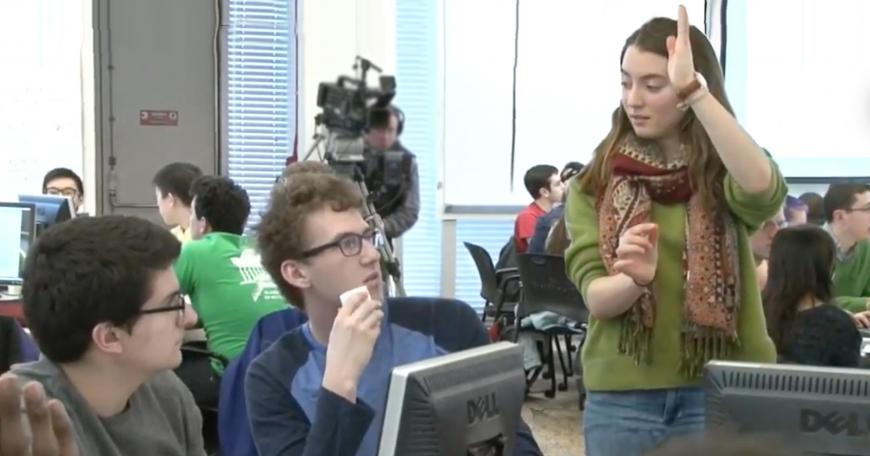TEAL + MITx

Physics 8.02, Electricity and Magnetism is a required course taken by over 800 MIT students each year. In the spring of 2014 it was one of the first courses to expand on the use of Technology Enabled Active Learning (TEAL) by incorporating the MITx platform.
Profesor John Belcher partnered with co-principal inverstigators Dr. Peter Dourmashkin and Professor David Lister to develop a classroom that leverages technology in support of hands on learning.
The TEAL format implements many elements of a "blended classroom," including in-class activities focused on peer instruction, group problem solving, and interaction between course teams and students. In Physics 8.02, students tackle problems cohort-style to discuss electromagnetic phenomena, with each group working from a networked computer that links to desktop experiments, media-rich software for multimedia visualization, and course notes.
While TEAL helps enhance the in-class learning experience, the Department of Physics and its lecturers wanted to improve how students were learning outside of class. The Department faced challenges to creating this richer external learning experience, such as finding methods to deliver timely feedback, and discovering ways lecturers could better assess the comprehension levels of their students.
Adding the x
The Department of Physics worked with the Office of Digital Learning to create TEAL+x, a platform that combines the collaborative learning experience of the TEAL format with MITx. The MITx platform allows both faculty and course teams to organize presentations, as well as pre-class and homework assignments, all in one place. With MITx, lecturers can be more explicit about their expectations, while students, like the ones enrolled in Physics 8.02, can receive immediate feedback about their work.
The combined format of TEAL and MITx is helping students assess their understanding of class material even before they enter the classroom. For example, TEAL+x has transformed how pre-class reading exercises are assigned and assessed. Students are required to complete selected textbook readings, which are embedded in the platform, and they submit answers online to assigned questions prior to class. TEAL+x automatically alerts them if the answers are correct, without showing the solution. Students are then able to complete problems again, pushing them to focus on the process of finding the right answers.
Samantha Briasco-Stewart, a student majoring in Electrical Engineering and Computer Science (EECS) at MIT, took part in the first Physics 8.02 course to utilize the MITx platform. The sophomore says the integration of the platform was a welcome change from the prerequisite 8.01 course.
With TEAL+x, we were able to submit our answers to homework problems online, and we could instantly see if they were correct,”-- Samantha Briasco-Stewart, undergraduate student majoring in EECS
Samantha describes the in-class experience as an organic combination of learning formats. "There is still a lecture portion, but there is also time to work on problems in class as a group," she says. "It’s helpful to work on exercises while the material is fresh in your mind, and the teaching assistants are there to help."
The combination of the TEAL format and the MITx platform enables students to conduct laboratory experiments, interact with their experiments by submitting answers to questions related to their observations and measurements, and receive automated feedback that is personalized to their answers. So students will know if they are on the right track or if they need to consult with a teaching assistant for additional help.
Instructors can see color-coded tables that show which students need extra help, so they can make sure everyone is on track. The tables indicate overall progress, as well as the progress of each group of students in an experiment. Instructors can also use automated grading of the experiments and have the system automatically upload grades to their gradebook. This means that teaching assistants should spend less time grading papers and filling in gradebook sheets and more time helping students.
The impact of TEAL+x
Midway through the semester, the first group of TEAL+x students was asked to complete a survey regarding their MITx experience. An overwhelming number of respondents —nearly 95% — said that Physics 8.02 should continue to utilize the MITx platform. Many reported that the format improved their preparation for class, and that the immediate feedback led to better study habits.
Following on the success of the TEAL+x experiment, the Department of Physics introduced the use of MITx in Physics 8.01. Dr. Saif Rayyan, a Fellow and Lecturer in Department, commented that the TEAL+x experiment is helping students digest the material and prepare for class in ways that simply weren’t possible before.
We don’t want students to spend more time doing problem sets. We want them to spend their time more efficiently and to understand the process behind the correct answer.”– Dr, Saif Rayyan, Fellow and Lecturer
In the years to come, TEAL+x will help build a library of content and make changes to improve the pedagogy as well as the learning experience for students. "Technology in the classroom is alive and evolving," says Dr. Rayyan. "We are hearing that the format feels natural to students. They’re coming to class prepared to dive deeper into the material."

